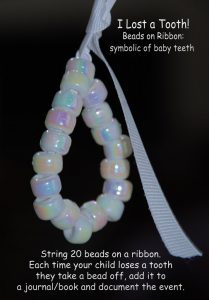
“How is it possible for the child’s imagination to be developed by that which is in truth the fruit of the adult’s imagination? We alone imagine, not they; they merely believe.” -Maria Montessori
Recently, Nishad lost two of his baby teeth. As I held his first tooth in my hand, I smiled and reflected about the excitement when, not-so-long ago, this very tooth was the first tooth in our baby’s mouth. Despite knowing that we weren’t about to indulge in fictitious stories about a “Tooth Fairy,” I was unprepared when it first happened. I was scrambling as to how to mark the milestone.
Like Santa Claus and the Easter Bunny, we choose to tell our boys the truth. The Tooth Fairy would be no different. Surely, this doesn’t resonate well with some parents and isn’t about to win us any popularity points. I’ll never forget another Mother telling me about how another child ruined the ‘magic’ of Santa Claus for her child. “Why do THEY have to ruin the fun?” I guess I can re-phrase that with, “Why do the Kumar Family have to ruin the fun?”
We completely respect others choice in rearing their children how they wish—this is just a personal choice for our family. Not intended to be “preachy” but rather a mere glimpse or perspective of one family that is doing the best they can at “keeping it real.” (As you make a mental note not to invite us to any 2011 holiday cookie exchanges.) I say this as the kid who, like all of my friends, believed in Santa, the Easter Bunny and the Tooth Fairy. Did my parents damage me for life? No. Was there a bit of shock to my world when I learned the truth that the very people I grew to grow and trust lied to me in the name of “fun?” Definitely. Are there times when a parent feels they have to lie to the children? Surely… but for us, it wouldn’t be over commercial concepts and ideas aimed at profiting. Are our holidays less stressful? Yes. The emphasis isn’t on the gifts because we’ve minimized the commercial expectations of the season.
Prior to Nishad being born, I worked with a few amazing AMI Directresses that each had over 30 years of experience. I was lucky to engage in conversation with them and a hand full of other Montessorians in regard to the holidays and “fantasy” in general. Though, I was influenced by their Montessori perspective, experiences and readings on the subject, I must admit that it wasn’t the only reason why we decided to choose this path for our children. So here are some personal reasons, from the flip side of parenting without fantasy, in 0-6 years:
-
- It destroys a perfect opportunity to give your children the best kind of example – the unconditional love of a parent. If your child is completely convinced that Santa Claus, based on how good you’ve been, will dole out presents at his own discretion, there’s an alternative motivation for acting right. Instead, we love our kids for who they are.
-
- While we embrace world religions, we are Christian. Why do we call this holiday “Christmas?” Because it’s the time that we celebrate the birth of Jesus Christ. And this goes hand-in-hand with my observation about showing the unconditional love of a parent. You don’t need Santa Claus to make your wishes come true. You have a father and/or mother who care enough about you to do everything we can to make your life the best that it can be.
- Belief in Santa Claus does nothing to “enhance” a child’s Christmas experience. We still enjoy light-gazing and decorate. A child can enjoy the experience without having to believe it’s real. With that being said, we took the boys to a holiday party where Santa was. Nishad looked at me, lifted an eyebrow and said softly, “Mama that old man dressed in the red clothes must think its Halloween again!” Of course, a part of me was relieved that he said it softy to me so that I didn’t have 50 other parents chasing me down outside as we made a b-line to the car because we “ruined their child’s holiday.”
As adults, we use the words imagination and fantasy interchangeably. However, they are not the same thing. I came across an article written by Pilar Bewley, an AMI primary teacher in Italy. Here are some highlights:
-
- “We are all aware that creativity stems from a well-developed imagination. You have to imagine something before you can create it, right? We also rightly assume that the capacity to imagine is formed in early childhood (a time when children are read fantasy stories and are encouraged to participate in pretend-play). And yet, you won’t find a single fairy tale, doll, or talking animal in a Montessori Children’s House classroom.”
-
- “Fantasy can be a great tool for escape and entertainment for those of us who have a strong grip on reality. However, young children (before the age of 5 or 6) are not able to differentiate between fantasy and reality; a phenomenon that has dire repercussions on their ability to learn and problem-solve.”
- “Fantasy can be a great tool for escape and entertainment for those of us who have a strong grip on reality. However, young children (before the age of 5 or 6) are not able to differentiate between fantasy and reality; a phenomenon that has dire repercussions on their ability to learn and problem-solve.”
-
- “Young children can certainly use their imagination, but their main focus is the reality around them. However, around the age of six, the child begins to question how everything around him works. He’s no longer content with learning through his senses: feeling, seeing, tasting a fruit, and finding out its name, for example. He wants to know where it came from and how it was made!”
- Dr. Montessori explains. “Our aim therefore is not merely to make the child understand, and still less to force him to memorize, but so to touch his imagination as to enthuse him to his inmost core.” Furthermore, “Pretending is largely assimilation of reality to one’s own thoughts, rather than adjustment of one’s own ideas to fit reality,” writes Dr. Angeline Stoll Lillard in Montessori: The Science Behind the Genius.
So what did we end up doing to mark the milestone of losing a tooth? We traveled around the world and discover the surprising things children do when they lose a tooth.

There is a wonderful book by
Selby Beeler, Throw Your Tooth on the Roof: Tooth Traditions from Around the World we used as a guide. In addition, we have a string with 20 white beads (originally) on it which are symbolic to 20 baby teeth. For each tooth lost, Nishad (and eventually Arun) remove a bead, and we place it in a journal and document the occasion with the details surrounding it along with a picture.
So now that our secret is out, we hope we’re not on your naughty list.
